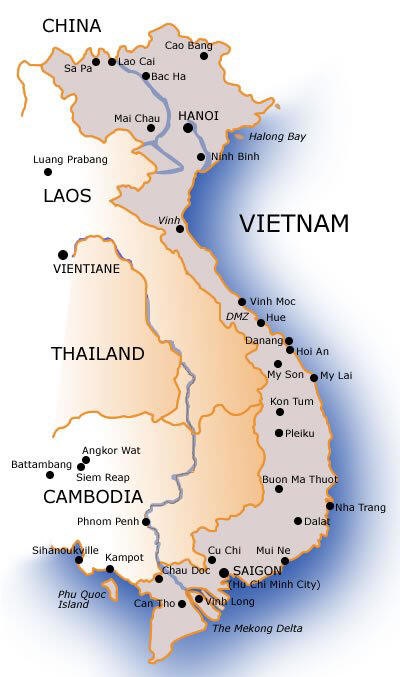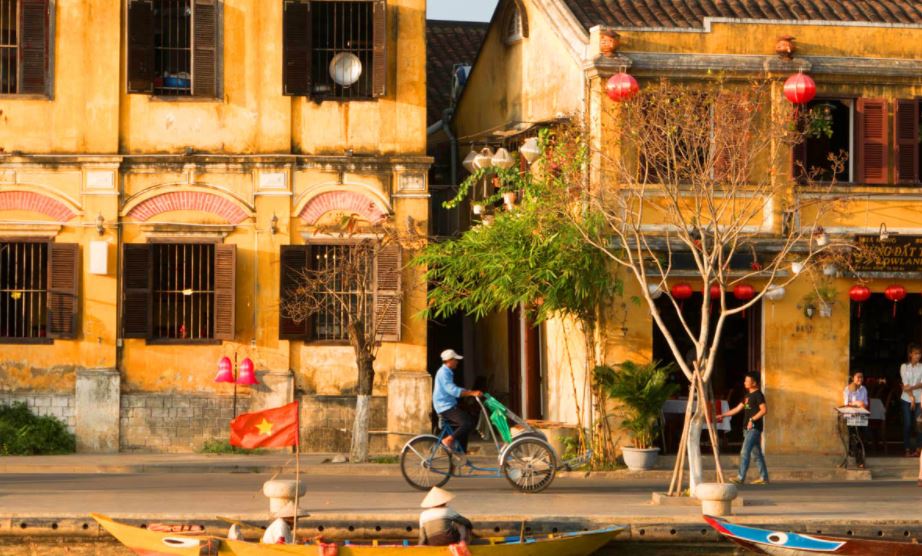Our Destination & Beyond

Vietnam is a country of contrasts. The chaotic din of the cities - dirty, dusty and crawling with mopeds - slowly fades to reveal a vast patchwork of vivid green rice paddies specked with conical hats. The cities cannot be ignored – vibrant, heaving, and at times dangerous (trying to cross the road is tricky to say the least) – but stay too long and the din becomes too loud. If you’re visiting Vietnam’s capital city, Hanoi, the perfect antidote is a trip to Halong Bay.HERE ARE SOME QUICK FACTS
When to go
Vietnam is a year round destination, and has a tropical monsoon climate with wet and dry seasons, which vary from north to south. In general, the dry season lasts from November to April in the north, south and central highland regions. The coolest, driest times to visit are: Oct to Jan (north), Feb to Apr (central highlands), and late Dec to Mar (south). Hoi An, Hue & Danang in the centre of Vietnam have hot and dry weather from mid-January to late August, with temperatures often reaching the mid-30's °C. During the winter months the rainfall increases with October and November achieving peak levels, occasionally in the form of typhoons. When to go
Air
Vietnam Airlines fly the main domestic routes and operate some international flights.Train
The Reunification Express runs between Hanoi and Ho Chi Minh City, is 1726 km long & takes 33 hours. Recommend Soft Sleeper class (two tiers, four beds per compartment) for longer / overnight journeys.Cyclo
An excellent and cheap way to get around the cities and towns. Settle on fare before getting in, around US$1 per hour. Always pay the exact amount in cash, don't expect change.Bicycle
A great way to get around Hanoi, Hoi An and Ho Chi Minh City. Easily rented from hotels and cafes.DANANG
This city by the sea is one of Vietnam’s most vibrant metropolises. Traditional and contemporary co-exist: find international standard shopping and dining facilities as well as local market places and restaurants.Look out for great local delicacies like Banh Khoai, crepes filled with shrimp, pork, egg and bean sprouts. Bun Bo Hue, a spicy noodle soup with beef and pork and Com Hen, rice with clams.
Danang’s beach is said to be one of the best in Asia and it is no suprise five-star resorts are springing up along its 30km stretch. The beach also has some history, it is where American soldiers would be sent for a bit of R & R.
Discover the stunning vistas from Son Tra Peninsula. Step back in time at the historical Cham Museum. Explore the enchanting Marble Mountain or tropical rainforests of the Ba Na Hills.
Points of Interest
You can easily access the best attractions on the central coast:• Marble Mountain
• Hoi An Ancient Town
• Cham Museum
• Bana Hills
• Han Market
• Hue City
SAIGON
A stroll along Saigon's most famous street, Dong Khoi takes you past the Caravelle and Rex hotels made famous in the war. Popular sights include the Reunification Palace (former Presidential Palace), & the War Remnants Museum leaves most visitors shocked and stunned at the graphic war photos on the walls. Ben Thanh Market is the largest market in Saigon. Local and imported products ranging from garments and textiles to handicrafts, flowers, and vegetables can be found here. Cu Chi Tunnels - 250kms of underground tunnels by hand in a war. The Viet Cong lived in these tunnels, out of sight of the Americans & section tunnels are open to visitors.
Known as the food bowl of Vietnam, it is formed by various tributaries of the mighty Mekong River. The gateway is My Tho, approx two hours drive south of Saigon. Day trippers will get to ride on sampans along the busy Mekong River and see the hundreds of boats plying the water with market goods. On land you can visit coconut candy factories, fruit farms and small local villages. We recommend spending a few nights in this area so you can get right into the Delta. Two day cruises depart from Saigon to Can Tho or to Ben Tre where there are opportunities to see floating villages & markets. Cruises through to Phnom Penh & Siem Reap Cambodia are a popular way to combine Vietnam & Cambodia.
HOI AN

The old town, a UNESCO World Heritage Site, has narrow pedestrian-only streets and is a great place to wander around. Silk abounds, and many clothing shops can be found in Hoi An - it is cheaper to have clothes made here than in Saigon or Hanoi. The town is also home to dozens of art galleries, textile houses and museums. The best way to get around Hoi An is by cyclo, on foot or hire a bike. A half-hour pedal (5kms) at a leisurely pace along a country road brings you to popular Cua Dai Beach. Hoi An is a real favourite in Vietnam and a week can easily be spent here.
HANOI
Tree-lined boulevards, parks, lakes and elegant French villas and colonialera buildings painted in muted hues of yellow and orange. The tree-lined shores of Hoan Kiem Lake is the heart of Hanoi, and is where residents perform mesmerizing "Tai Chi".The Old Quarter, also known as the 36 Streets. Each street is named for what it sells, eg. Silver St, Gold St, Shoe St, Fish St, Tin St, Bamboo St etc. making it a great place to shop. Most hotels are located in the old quarter.
Visiting Ho Chi Minh's Mausoleum is an unforgettable experience, as inside an imposing building lies the embalmed body of the founder of modern Vietnam. Water Puppetry, a remarkable Vietnamese art form combining music, fireworks and elaborate puppets floating gracefully on the water. The stories depict Vietnamese legends and festivals.
HALONG BAY
Located in the Gulf of Tonkin 170 km from Hanoi, Halong Bay is an impressive collection of nearly 3,000 islands covering an area in excess of 1,500 km forming a spectacular seascape of limestone pillars and cliff faces. Many of the forested islands in the Bay have hidden caves & grottoes which are easily explored by boat or kayak. A full exploration of Halong Bay takes 2 to 3 days, though a day trip ex Hanoi provides enough time to get a feel for the place. Cruising can be done on the traditional junks which are available in 3-5 star or on the paddle steamer ‘Emeraude Classic’.
HALONG BAY
SAPA
Located in Lao Cai province, 350 km from Hanoi, close to the border with China. The town of Sapa lies at the attitude of about 1,600m. The climate is moderate, cool in summer, foggy and cold in winter with occasional snowfall. Sapa is home to a great diversity of ethnic minority people. Stunning mountain scenery with colourful hill tribe people & rice paddies. The Saturday markets are famous for their colours and a great opportunity to interact with the locals. Sapa is a great area for those who are interested in trekking. Journey by overnight train from Hanoi to Lao Cai located in the Sapa region.
HUE
(pronounced 'whey') is a UNESCO World Heritage Site, where you will see the remnants of Hue's royal past with tombs of Emperors, moated ruins of Citadels and Vietnam's best known pagoda, Thien Mu - a seven-storey stupa, 21 metres high, with each level dedicated to one of the various human forms taken by Buddha. A sampan trip on the Perfume River is a must, as many of the attractions can be found on the River, like the Thien Mu Pagoda and a number of Royal Tombs. Hue's spectacular Citadel is built on the same principles and design as Beijing's Forbidden Palace.HUE
NHA TRANG
A popular beach town with plenty of hotels & great restaurants. Day cruises are available along the coastline or experience the local mudbaths. Dalat: Good area to see a change of scenery with a crisp mountain climate and rolling hills. Has a unique collection of buildings and attractions.